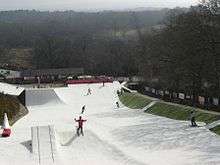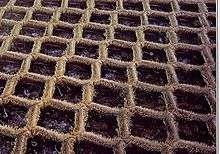Dry ski slope

A dry ski slope or artificial ski slope is a ski slope that mimics the attributes of snow using materials that are stable at room temperature, to enable people to ski, snowboard or snow tube in places where natural, snow-covered slopes are inconvenient or unavailable.
Although commonly known as "dry ski slopes", many slopes are lubricated using a mist or jet system to increase speed and prevent damage to equipment from friction heat build-up. As a general rule, they are found predominantly in the United Kingdom and the Netherlands as other European countries tend to have ready access to real snow fields, as does North America in the winter.
Materials
Early materials
A variety of materials can be found on dry ski slopes.
Early efforts to mimic snow involved laying extruded plastic tiles with upward spikes in an attempt to provide grip. These were unpopular as they provided little grip and turning capability and the experience was similar to skiing across ice.
However, in present day, many ski slopes (both indoor and outdoor) continue to use plastic, injection moulded tiles. Quality has improved and many dry ski slopes in the Netherlands use these tiles for training and championships.
Brush materials

The next stage in dry ski slope development came with the brush industry. The most common material is dendix, a by-product of brush manufacturing which is similar to a short-haired brush with the bristles sticking upwards. Dendix is manufactured in Chepstow, however it can be found on slopes throughout the world.[1] It is arranged in a hexagonal pattern of approximately 1 inch (25 mm) strips of bristles in a 4 in (100 mm) hexagon. Although it was a significant advancement from previous surfaces, concern over damage to slope users (it provides little or no impact protection to a slope user when falling) and ski or snowboard damage due to friction meant litigation for slopes using it was a constant threat. Nowadays water is often sprayed onto the surface of the dendix to lubricate it and increase speed; however, higher insurance premiums cause many slope operators to look for safer alternatives.[2]
Despite more recent materials, Dendix remains the most popular plastic slope material in use.
Recent materials

with stapled seams]]
Another very common mat is Snowflex, manufactured near Huddersfield, West Yorkshire in England by Briton Engineering Developments Limited. Others include Perma-snow by John Nike Leisure/ Techmat 2000, also in the UK and Astroride by NorCal Extreme Sports in the United States. Snowflex and Perma-snow are both white in colour, although the former has been produced in a darker green (such as in Kendal Ski Club in Cumbria, England) to comply with planning requirements.[4][5] There is no indication from NorCal Extreme Sports that AstroRide has been commercially tested to any great extent.[6]
Ski and board preparation
Dry slope users often improve the performance of their equipment by using the hardest grade of ski wax. The wax wears off quickly, however, and must be renewed after one or two sessions. At least one company makes a hard wax that is intended for use on dry slopes.[7] Some users apply aerosol furniture polish or other can based products to the bases of their skis or boards as the silicon oil it contains is reputed to reduce friction. Other substances, such as dishwashing liquid, are sometimes used.[8]
See also
References
- ↑ The Western Mail (18 November 2002). "Dendix installing ski slope in Moscow". Natives.co.uk. Retrieved 10 May 2010.
- ↑ Shephard GJ, Saab M, Ali KH (March 2000). "Upper limb in injuries in dry ski slope skiing—a continuing problem". Eur J Emerg Med. 7 (1): 31–4. doi:10.1097/00063110-200003000-00006. PMID 10839376.
- ↑ "Neveplast NP30 product page". Neveplast Italia. Retrieved 18 April 2011.
- ↑ "Minutes of South Lakeland council meeting" (PDF). Retrieved 10 May 2010.
- ↑ Snowboard Club UK. "Discussion on synthetic surfaces". Snowboardclub.co.uk. Retrieved 10 May 2010.
- ↑ "NorCal Extreme Sports news page". Astroride.com. Archived from the original on 15 February 2009. Retrieved 10 May 2010.
- ↑ "Plastic Slope Fluoro Waxes". Datawax. Retrieved 26 August 2009.
- ↑ "James Gambrill reports from the Kings Ski Club National Finals, 08 May 2007". Retrieved 26 August 2009.
External links
 Media related to Dry ski slopes at Wikimedia Commons
Media related to Dry ski slopes at Wikimedia Commons
